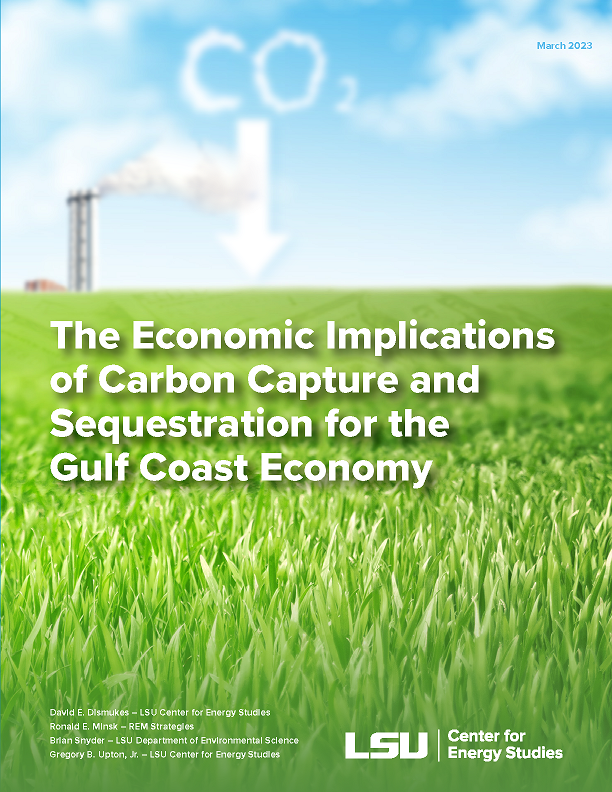LSU Estimates that Local Carbon Capture and Sequestration Project Could Help Decarbonize
Energy Industry while Supporting Jobs

Posted March 20, 2023
A new report from LSU’s Center for Energy Studies estimates that a planned carbon
capture and sequestration hub to be located in Calcasieu Parish could abate climate
damage, support jobs and workers, and protect the energy industry by capturing industrial
carbon emissions and storing carbon dioxide permanently underground.
The report, prepared for Gulf Coast Sequestration, estimates the regional and national
economic implications of GCS’s planned carbon capture and sequestration hub. Produced
in partnership with GCS, the report is authored by David Dismukes, professor emeritus,
LSU Center for Energy Studies; Greg Upton, interim executive director, LSU Center
for Energy Studies; Ron Minsk, an energy and environmental policy consultant who served
as a special assistant to President Obama for Energy and Environment and special assistant
to President Clinton for Economic Policy; and Brian Snyder, associate professor, LSU
Department of Environmental Sciences.
GCS plans to build the first hub in the United States to permanently store carbon
dioxide emissions. Its target market is large industrial facilities looking to reduce
their lifecycle greenhouse gas emissions to preserve the economic competitiveness
of the region.
The planned GCS hub is located in Calcasieu Parish, near an important industrial corridor
that includes some of the largest fuel and petrochemical manufacturers in the U.S.
The report notes that these processes create “hard-to-abate” emissions for which carbon
capture and storage “offers a clear pathway to an improved carbon footprint, which
can allow such activities to continue and thrive in a low-carbon environment.”
“Under current technologies, this is a realistic pathway for the region to achieve
rapid decarbonization over the next decade,” Upton said.
“At GCS, we are committed to thorough research, including conducting hundreds of models
and simulation exercises to examine how our project will impact our environment and
our community,” said Gray Stream, CEO of GCS. “This report is another aspect of that
research, and we are pleased to have worked with LSU to analyze the project from an
economic perspective. The GCS hub represents a forward-looking opportunity to help
to grow and sustain American industry and jobs, while also ensuring environmental
protection now and in the future.”
The study found that the GCS project could have the following economic impacts:
- The potential to abate climate damages by $11.3 billion over the lifetime of the project (utilizing EPA’s social cost of CO2) by sequestering a total of 300 million tons of CO2.
- An estimated contribution of $698 million in earnings for U.S. workers during the anticipated five-year construction period, with approximately $560 million of this occurring in Louisiana and Texas.
- Support for more than 1,149 jobs nationally during construction, with more than 970 of these jobs in Louisiana and Texas.
- Support for approximately 375 jobs nationally once the project is completed, paying $21 million in earnings annually.
- Assistance in the decarbonization of - and thus protection of - an industry that employs approximately 150,000 workers directly in Texas and Louisiana alone.
The report explains that the benefits of decarbonization are at least two-fold: First, decarbonizing makes current jobs in these sectors potentially more resilient in a lower carbon future; and second, a reduced carbon intensity is increasingly becoming an important factor as companies are considering siting in the Gulf Coast or other regions.
The report states that successful decarbonization can “create a competitive advantage for the region, which can continue to export products such as liquid fuels, chemicals, fertilizers, and plastics globally. These products do not currently have viable substitutes.”
GCS has submitted two applications for Class VI Underground Injection Control permits from the U.S. Environmental Protection Agency (EPA) and is prepared to move forward to construction once permits are received.